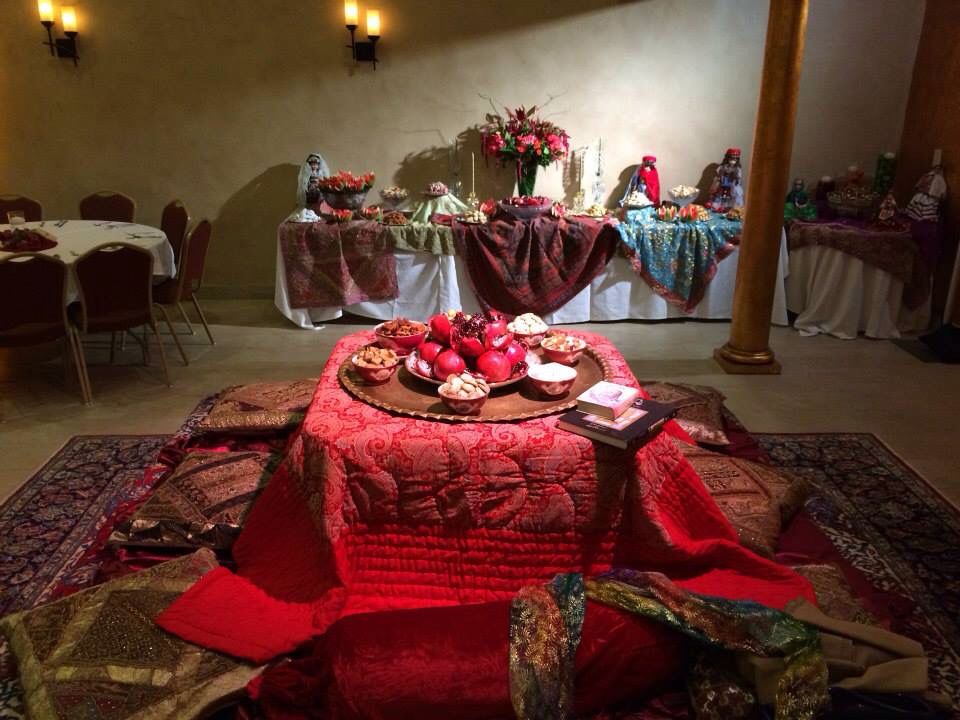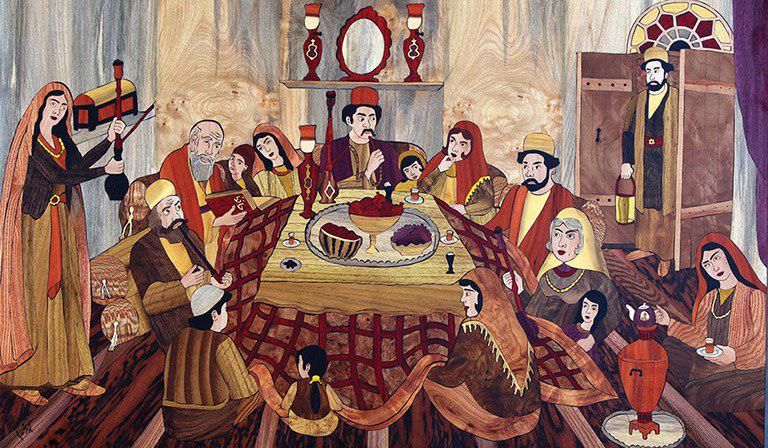Yalda Night
Yalda Night, the celebration of the longest night of the year

Every year on the 30th of Chance in the Iranian calendar, Iranians and all people living in the territories of Iranian cultural influence (the countries of Central Asia, including Afghanistan, Uzbekistan, Turkmenistan, Tajikistan and some Caucasian states such as Azerbaijan and Armenia, and some parts of Pakistan, India and Kashmir) have celebrated for centuries the arrival of winter – the winter solstice -, the renewal of the sun and the victory of light over darkness on the Night of Yalda (or šab-e Yaldā; also, šab-e čelleh). It is the longest night of the year, and they celebrate it with various festivities and rituals and symbolic acts. The night of Yalda is the result of the vision of the Persian culture on this natural event and is considered the most important Iranian celebration after Nowruz (celebration of the beginning of the Persian New Year).
Yalda takes place in the period of time between sunset on the last day of autumn (30 Azar in the Iranian calendar, equal to Gregorian December the 21st) and sunrise on the first day of winter (1st Dey in the Iranian calendar, equal to Gregorian December the 22nd).
The term Yalda stems out of the Syriac language and means “birth” and, in that culture, this festival commemorated the birth of the god Mithra and the triumph of the sun over darkness (from the winter solstice the hours of light grow every day until the arrival of the summer solstice). It is considered one of the holy nights and one of the most important festivals of ancient Iran and it entered the official calendar of the ancient Persians from 502 BC. during the time of Darius I. The Iranian scientist and anthropologist of the X and XI centuries Abu Reihan Al-Biruni, called the celebration of Yalda “Milad-e Akbar“, which was understood as Milad-e Joršid “Birth of the sun.” The exact time of this milad-e akbar can be seen in the book entitled “Al-tanbih va al-ashraf” written by Al-Mas’udi. Mas’udi, a Muslim historian and scholar of the X century. The aforementioned book addresses the issue of the divisions of the four seasons and about the third season called Pāyiz (autumn) it reads: “The last night of autumn or the winter solstice is the 22nd of the month of December or the first day of Dey”. Al-Biruni calls the first day of the month Dey Jor, and the month Dey – jormah (month of the sun), however in other sources they call it jorram ruz, that means the same than jorruz (ruz-e joršid) – day of the sun. The Persian poet Ferdowsi claimed that Yalda festival had been celebrated since the time of Hushang, the king of the Pishdadian dynasty. Another name for this appointed day is Šab-e čelleh (the night of Lent), since the ancient Iranians divided the two coldest months of winter, Dey and Bahman, into two parts: Čelleh-ye bozorg, the great Lent (spanning the first bloody days of the white month), and Čelleh-ye kuchak, the little Lent (the next twenty days).

This winter celebration was of great importance to those whose way of life was based on agriculture and livestock and thus has been the most popular Iranian holiday among the rural masses. The mystery of the permanence of the night of Yalda to this day depends on several factors, mainly the following: Yalda’s connection with nature and the beginning of the new season that repeats itself with the eternal order every year; the dependence of this natural celebration on the lifestyle and type of work and livelihood of the Iranian peasant community and, third, the continuation and reflection of the ancient Iranian cultural identity in this celebration.
Yalda Night is a long-standing tradition that Iranians have long considered important. In ancient times, darkness was considered a sign of the devil, so on the night of Yalda, Iranians lit fires to protect themselves from the forces of evil thanks to the light of embers and flames. In this party, family and friends gathered around the fire in an attempt to banish the demon, they ate fruit, they spent the night happily, waiting for a new dawn. Yalda Night customs have not changed much over time and in more modern times, poems from Hafez and tales from Shahnameh (Book of Kings) are read.
Another crucial element tonight is guessing the future through Hafez. Among Iranians, there is a custom to ask this great poet questions about his life and problems: each member of the meeting makes a wish or asks a question, while keeping it a secret, and randomly opens the Divān-e Hāfez; then the older family member or friend reads the randomly selected poem aloud. Since the poem is believed to be the interpretation of the wish and the way it would come true, it is fun to interpret the poem and guess the wishes others make. Another common practice of the Yalda night is the reading of Shahnameh and the narration of epic tales composed by Ferdowsi. In addition, among the different local Iranian groups, there are other rituals and beliefs that are particular and differ from one region to another.
But what is common among all Iranians is the gathering of family, friends and acquaintances to spend the last night of autumn together. It is common for people to gather in groups of friends or family from dusk to dawn on the first day of winter, usually at the home of grandparents or the elderly to celebrate the longest night of the year. Since storytelling is an entertaining Yalda tradition, the elders entertain others by telling stories and anecdotes. On the eve of the Yalda, an indescribable passion arises among Iranian families who want to prepare for the night and when sunset comes the Iranians used to sit around a Korsi (a type of low table found in Iran, with a heater underneath and blankets on top), and today, people use heaters and other types of heating. Iranian families often cook a sumptuous dinner and buy nuts and a variety of fruits, usually watermelon and pomegranate. Each city and culture considers a special meal to celebrate that night. When the time comes the Iranians spread their tablecloth to the tradition of their ancestors and sit next to the tablecloth to celebrate the passage from old time to new.

The content of this tablecloth, which in some areas is called Jan-e šab-e čelleh, is different in each region of Iran and depends on the climatic, social and cultural qualities of indigenous communities, different habitats and traditions. But in general it is customary to eat pomegranates and watermelon, nuts and dried fruits since each of these is a symbol of health, vitality and happiness. Eating watermelon and pomegranate tonight has a mysterious meaning. The watermelon and pomegranate are the symbol of the sun and it is believed that if you eat a little of these fruits on the night of Yalda at all hours of winter, cold and illness will be overcome. Another of Yalda Night foods are sunflower seeds, due to the similarity of this flower with the sun (similarity of Helianthus annuus flowers with the sun and their circulation with the sun, they are called āftābgardān) eating its seeds is believed to bring luck. Fruits, especially red fruits (the red colour of these fruits is a symbol of the sun), play an important role in the delicious part of Yalda. The pomegranate is the main fruit of the Night of Yalda. The ancients considered the pomegranate to be the fruit of fertility and blessing, the pomegranate is also considered a symbol of happiness and the sun for its red colour. Watermelon, like pomegranate, is a special fruit for the Night of Yalda, among other fruits include those of autumn such as oranges and citrus, apples, persimmons, pears and even pumpkin. The sandwiches and nuts for the Yalda evening are even more important than the dinner itself. Nuts such as pistachios, walnuts, almonds and hazelnuts are essential components for the night of Yalda. Dried figs and berries can also be seen among the delicious part tonight.
The Yalda Night ritual takes place in different cities of Iran according to the culture and geography of the city, each of which has its own charms; However, some of them have been forgotten and only a memory of them remains.
In the eastern parts of the country (Khorasan) the old custom of preparing and consuming kaf is still practiced, which is a kind of sweet that looks like foam. Another custom from specific parts of Iran and Khorasan on čelleh night is related to young engaged couples. Another ceremony that took place tonight in Khorasan was the Shahnameh ceremony, where the elders of the group dedicated themselves to writing songs and reading Shahnameh.

In Tabriz, the street musicians are known as Ashiq who walk through the neighbourhoods while singing, playing music, telling legends and stories.
In the Lorestan province it begins just after sunset, when young people would go up to the rooftops of the neighbours and begin to sing the song šov-e avval-e qāreh, where they hung a handkerchief from the roof of the neighbours from the house, asking them for treats. Zanjan is one of the few places where Korsi still has a practical use; and wherever there is a korsi, there will be a memorable reunion. In Yalda, local people serve their own local sweets, including the famous window-shaped cakes and baklava. In Sanandaj, the capital of Kordestan province, pan dolma y sangak are prepared for Yalda. Each year, as agreed between the families, the ceremony takes place in a different house.
The night of Yalda is highly reflected in Persian art and literature and artists have addressed various customs and aspects of this custom at different times. For example, the term Yalda has been used by poets and writers since ancient times, including Onsori, Rumi, Hafez, Saadi, Attar, Naser Josro Ghobadiani, Saeb Tabrizi y Mas’ud Saad Salman. These poets have used the term Yalda in their poems in the figurative sense of “long and dark.” Furthermore, some poets have compared the long black hair of beautiful women to the night of Yalda.
Because the Yalda Night and its traditions are so interesting, it was officially added to the List of National Treasures of Iran during a special ceremony in 2008.

(Contents based on different internet sources, mainly MEHRNEWS.COM and others. Images taken from the internet)

